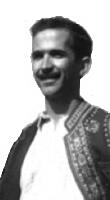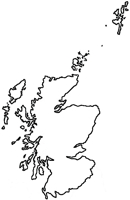
|
The Society of Folk Dance Historians (SFDH)
Scottish Country Dancing
[
Home |
About |
Encyclopedia | CLICK AN IMAGE TO ENLARGE |

|
See Standard Abbreviations for a description of the abbreviations below.
GENERAL
Information: The basic requirements of Scottish Country Dance styling is simple: erect posture, the ability to keep time to the music, and a friendly, helpful attitude. No amount of tchnical proficiency with steps and figures will excuse failure ot be pleasant twd the people with whom you are dancing.
Beyond these elementary skills, Scottish Country Dance styling requires a good turnout of the ft; the ability to carry one's weight on a slightly bent knee, often with the heels off the floor; and the ability to use arms and hands gracefully and smoothly.
STANDING
The basic standing (and starting) pos for the steps described here is called "First Position." Weight is carried evenly on both ft, and on the full ft. Body is held erect, with arms hanging loosely at sides, palms inward. Heels are together, toes turned out to form a 90° angle.
HANDS
When turning with one hand with a ptr, hands should use the same grip as for a gentle "Handshake" at shoulder level of the smaller person. When joining hands in a circle, the R hand is extended with palm up to receive the hand of the person to one's R; L hand is extended with palm dn, to be placed in the hand of the person to one's L.
SET
Starting pos for most Scottish Country Dances is called a "Long Way Set." This consists of a line of four M side by side, facing a line of four W. Usually, the set is arranged so that the music comes from the end of the set where the M L and W R sides are twd the music. This end of the set is called the "Top" of the set; the opp side is known as the "Bottom" of the set. For purposes of dance descriptions, cpls are numbered one (#1) to four (#4) from the Top of the set.
CORNERS
In many dances, the first cpl moves down between the second and third cpl into the center of the set facing straight downward and outward. When this occurs, the person on the R becomes the first corner and the person on the L becomes the second corner.
CASTING OFF or CASTING UP
Casting Off is a movement outward from a pos in a set and downward twd the bottom of the set. When done from a standing pos in the set, Casting Off consists a 3/4 turn away from the dir one intends to go to, before progressing in the required dir.
Casting Up is the same movement performed outward and upward twd the Top of a set.
SETTiNG
This is usually done facing another person in the group and is known as "Setting To" that person. It is an acknowledgement of that person, and is similar to the "Honor Your Partner" used in American Square Dances.
PAS-DE-BASQUE
Ct 1: Step on R slightly to the R, weight on ball of R.
Ct 2: Step L in front of R, weight on ball of L, L heel slightly over arch of R (R forms a "7" across heel of L), R thus rises minutely off the floor.
Ct 3: Step on R, weight on ball of R, and beginning to extend L diag fwd along the line it orig formed with R.
Ct &: Continue the extension of L, pointing L toe to keep it near the floor as L is extended outward.
Repeat action of cts 1-to-& with opp ftwk.
SKIP CHANGE OF STEP
This is a quick lively step used for "traveling" from place to place, again in dances with Reel (2/4 meter) or Jig (3/8 meter) time. Count for the step is "&-1-2-3" or "skip-1-2-3."
Ct &: Hop on L, bringing wt dn on ball of L, and at the same time extend R fwd in preparation to:
Ct 1: Step R, with wt on balls of both ft.
Ct 2: Close L up behind R, forming a "T" with L slightly touching heel of R, weight on balls of both ft.
Ct 3: Step R, weight on ball of R.
Repeat action of cts &-3 with opp ftwk.
SLIP STEP
This is used when travelling in a circle. The count is "1-&-2-&."
Ct 1: Step out to L, raising up on balls of both ft.
Ct &: Close R up with heel of L, weight on balls of both ft, toes turned out so ft form a 90° angle.
Ct 2: Repeat action of ct 1 of first meas.
Ct &: Repeat action of ct & of first meas.
Step moves to L. When moving R, reverse all movements.
DOCUMENT
- Scotland, a country
Used with permission of the author.
Printed in a Folk Dance Federation of California, South, Inc.
Institute Syllabus, February 1966.
This page © 2018 by Ron Houston.
Please do not copy any part of this page without including this copyright notice.
Please do not copy small portions out of context.
Please do not copy large portions without permission from Ron Houston.
